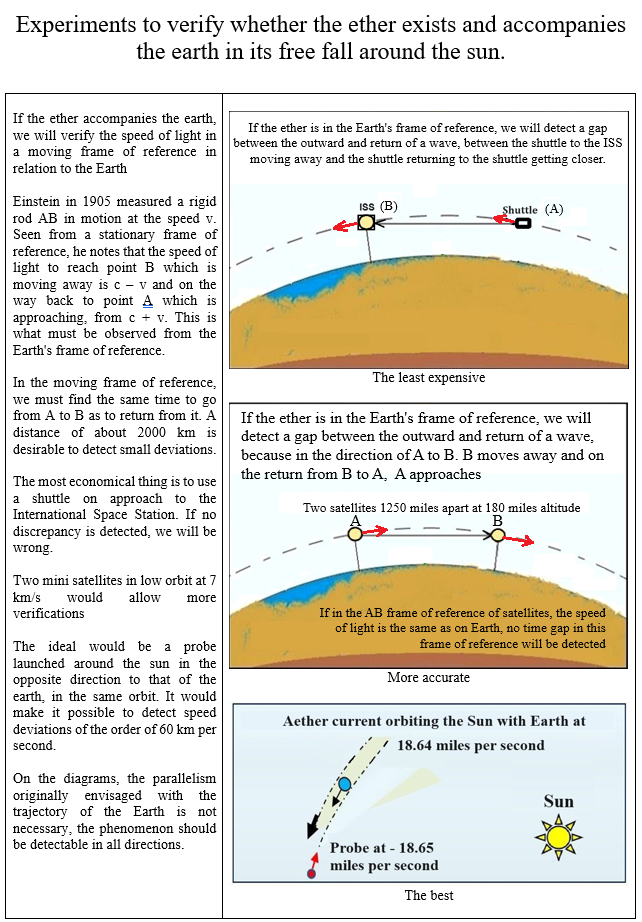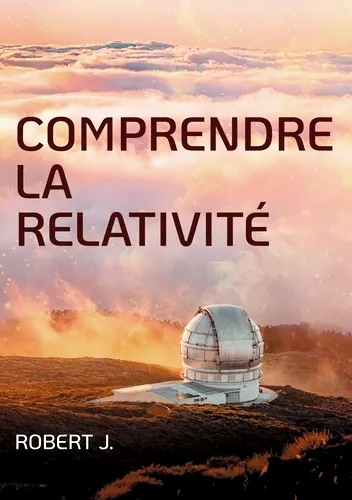Bonjour. visiteurs jour : 389
Français
Accueil - Welcome - Einstein's relativity - The ether - Miscellaneous - Galileo's relativity - Waves - References -
Relativity
Shadow areas to illuminate.
It seems that a lot of things have been forgotten

Galileo's relativity inspired Einstein
It is important to have a good understanding of Galileo's relativity of inertial motion, which explains that inertial motion is like nothing and undetectable, before moving on to Einstein, who uses it in its entirety without changing a comma.
Lorentz believes that the contractions he finds are real and explains the fact that we cannot detect the motion of the Earth in relation to the ether. Einstein rejects the ether (He will later say that it cannot be immobile, and we add: "in a gravitational field")
Here we just hope that you understand the interaction of Galileo's relativity with what is observed. This is a fundamental first step.
Einstein's Ether Rehabilitated
A Revolutionary SynthesisAbstract
This paper proposes a resolution to Einstein's decades-long struggle with the concept of ether by introducing the principle of free-falling ether. We examine Einstein's historical trajectory from rejection (1905) to rehabilitation (1920) to final abandonment (1938) of ether theory and demonstrate that the solution was implicit in his own work on free fall. We present two complementary hypotheses: (1) an ether in free fall that naturally accompanies all celestial bodies, and (2) a quantum ether composed of Planckian corpuscles. We propose a decisive satellite experiment to test these predictions and discuss their implications for unifying quantum mechanics, relativity, and classical physics.
1. Historical Context
1.1 The Initial Rejection (1905)
In his seminal 1905 paper "On the Electrodynamics of Moving Bodies,"(1) Einstein rejected Lorentz's ether a rigid, immobile medium that contradicted his observations of the constancy of light speed and his second postulate stating that this speed is identical in all inertial reference frames.
1.2 The Cautious Rehabilitation (1920)
Einstein introduced a "relativistic ether"(2) compatible with his theory by forbidding it from being at rest. He endowed it with matter interaction likely, inspired by the nascent concept of the graviton but encountered a crucial question: what motion should it possess?
1.3 The Frustrated Abandonment (1938)
Faced with the impossibility of defining this ether's motion, Einstein abandoned it(3). Yet he possessed the key, having transformed free fall into a principle of relative motion.
2. Hypothesis 1: Free-Falling Ether
2.1 Fundamental Principle
The ether cannot be at rest in the Sun's gravitational field Einstein was correct. However, its motion is not mysterious: it is in free fall.
Galileo demonstrated that all bodies in free fall descend at the same velocity, regardless of their mass. The ether, composed of masses too small to be individually detected, follows this same universal law and accompanies all celestial bodies in their free fall.
2.2 Extraordinary Implications
The ether accompanies all celestial bodies in their free fall
Light speed remains constant because its medium (the ether) perfectly follows inertial reference frames
On Earth, Mars, or Neptune: same local ether, same light speed
Free-falling reference frames become naturally privileged
3. Hypothesis 2: The Substance of Ether
This second hypothesis, independent of free fall, proposes an identification of Newton's corpuscles based on Max Planck's quantum of action.
3.1 From Planck to Newton: An Unexpected Synthesis
3.2 Mathematical Revelation
The equivalence between electromagnetic radiation pressure and gas pressure gives us E = mc². For an energy quantum, this relation becomes:
h = mc², m = h/c²
Result: The ether would consist of corpuscles of mass h/c², so infinitesimal that they escape current detection. Newton's corpuscles make their return!
3.3 Quantum Ether
These corpuscles might interest quantum mechanics specialists who envision "pixelated" space. We consider them simply as supports for electromagnetic waves considerable mass quantities per unit volume, possibly a form of invisible dark matter that transcends the photon concept.
4. A Decisive Experiment: The Satellite Test
4.1 Experimental Challenge
If free-falling ether accompanies Earth, we must find a reference frame sufficiently "empty" of matter to avoid disturbing its relative motion, while allowing observation of its velocity's influence on light propagation.
4.2 Protocol
Configuration: Two satellites in low orbit (velocity >= 7 km/s), separated by 2000 km, in the ecliptic plane. Twice per orbit (at noon and midnight), they align parallel to Earth's displacement.
Measurement: At these critical moments, they exchange waves and precisely measure round-trip travel times.
In the satellite reference frame (orbital velocity v = 7 km/s):
tref = 2000/300,000 = 6,666 666 ms
Forward time: t1 = L/(c - v) = 2000 km/(300,000 - 7) km/s = 6,666 822 ms écart = + 16ns
Return time: t2 = L/(c + v) = 2000 km/(300,000 + 7) km/s = 6,666 651 ms écart = - 15ns
Expected difference: Δt ~ 30 nanoseconds
This difference is easily detectable by atomic clocks precise to the picosecond (~10-¹² s).
4.3 Feasibility and Perspectives
The experiment is technically feasible. The difficulty would lie in analyzing local per
turbations. Multiple measurements at different points and their repetition would help clarify perturbations to consider.
More ambitious experiment: A probe placed in Earth's orbit in the opposite direction could amplify the sought effect!
5. Why This Theory Merits Attention
5.1 It Reconciles
Physical intuition (need for wave support)
Observations (constancy of c in inertial frames)
Einstein's legacy (free fall as fundamental concept)
5.2 It Unifies
Quantum mechanics (quantization by corpuscles)
Relativity (ether compatible with Einstein's principles)
Classical physics (return to Newton's corpuscles)
5.3 It Predicts
Effects measurable with current technology
New understanding of electromagnetic propagation
Unexpected links between gravitation and electromagnetism
6. Appeal to the Scientific Community
This hypothesis does not contradict Einstein it completes his reflection. It does not reject modern physics it complements it by giving physical substance to abstract concepts.
The history of science shows that the greatest revolutions often arise from synthesizing apparently incompatible ideas:
Newton found corpuscles without waves
Planck found quanta without their substance
Einstein found free fall without seeing it as ether's motion
It is time to assemble these puzzle pieces.
7. Conclusion
This revolutionary synthesis merits study, testing, and debate. If proven correct, it could change our fundamental understanding of the universe paradoxically by building upon the deepest intuitions of its greatest thinkers.
The proposed satellite experiment offers a concrete path to test these predictions with current technology. The implications for our understanding of space, time, and the quantum nature of reality could be profound.
References
1 1905 On the Electrodynamics of Bodies in Motion. A. Einstein.
2 1920 Acceptance speech at the University of Leiden. 1921 The Ether and the Theory of Relativity.
3 1938 The Evolution of Physics Albert Einstein and Leopold Infeld
4 1905 On a Heuristic Point of View about the Creation and Conversion of Light (1905).


Albert Einstein

Isaac Newton

Galilée

